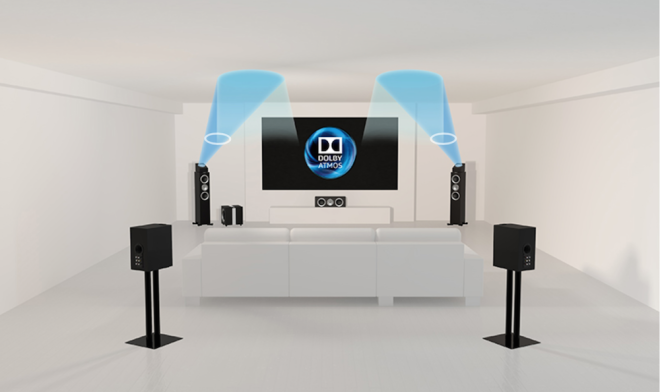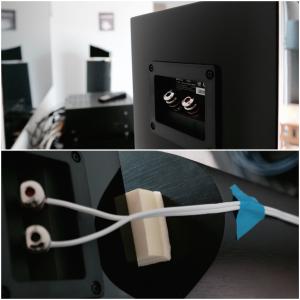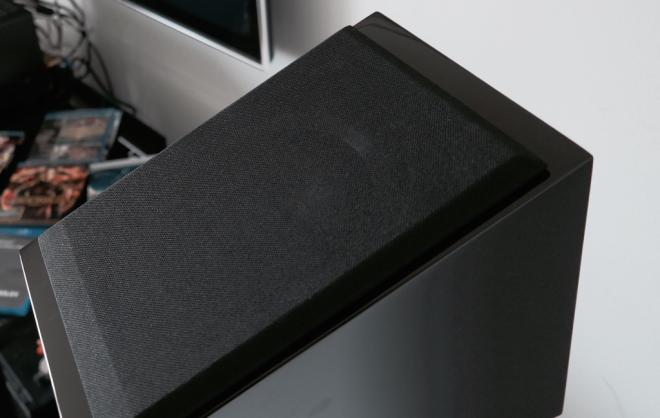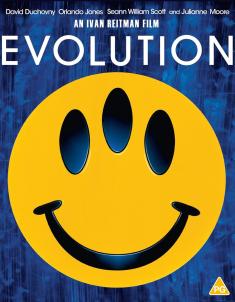KEF R50 Dolby Atmos Speaker Module
Overview -I've spent much of the last few years demoing and covering Dolby Atmos in theatrical cinemas as well as the format's home implementation. Atmos uses object-based sound mixing along with height speakers and individual speaker amplification to create a hemispherical sound experience that is pinpoint immersive. Competing technologies include Auro 3D (or 11.1) and the forthcoming DTS:X.
At home, current generation flagship-level Dolby Atmos AVRs are limited to eleven amplified speakers. That means you can scale your system from 5.1.2 (five ear level speakers and two height speakers) all the way up to 7.1.4 or 9.1.2 arrangements (seven to nine ear-level speakers and two to four height speakers).
To make Atmos setups even more flexible for consumers, Dolby has partnered with companies like KEF and Pioneer-Onkyo to design products that don't require any in-ceiling installs. Say what? Yep, with Dolby Atmos in the home, you can choose to mount actual in-ceiling speakers for your height channels or, if you have a flat ceiling somewhere between eight and fourteen feet tall, you can use a Dolby Atmos-enabled speaker, which bounces height sound effects off your ceiling.

Enter Stage Height: KEF R50 Dolby Atmos-enabled Speakers
While some companies, like Pioneer, offer speakers with built-in Dolby Atmos capabilities, others like KEF have gone the "add-on module" route. Add-on modules are a plug-n-play solution for those of us who already love our speakers and find ourselves unable to install in-ceiling speakers, but still want to experience Atmos immersion.
Having spent most of my Dolby Atmos Blu-ray coverage with 5.1.4 systems, I found myself missing a 7.1 system's side surround channels, which are vital for a 180-degree wrap-around sensation. Keeping that in mind, I've been looking to demo 7.1.2 or 7.1.4 for most of this year. Thankfully, the kind folks at Dolby, KEF, and Onkyo delivered big time, taking my 7.1 system and ramping it up to a 7.1.2 with power from Onkyo's flagship TX-NR3030 (review forthcoming) AVR, and height channel effects courtesy of the KEF R50 add-on modules.
We'll dive in more soon, but let's just say I've been having an absolute blast.

KEF R50 Specifications & Set Up
The KEF R50, as of this writing, are available directly from KEF for less than $1,200, though you may even be able to find a better deal through a local dealer.
The R50 features a closed box design finished in glossy piano black and each module weighs slightly less than 10lbs (4.5kg). The internals are comprised of the KEF Uni-Q driver array, which combines a 1" (25mm) vented aluminum dome tweeter with a 5.25" (130mm) aluminum woofer for mid and lower frequencies. At 90dB, KEF states the R50 has a <0.4% Total Harmonic Distortion. Produceable frequency range at -6dB is 96Hz - 19.5kHz.

These speakers are designed to sit atop KEF's other R-series speaker offerings, which range from the $1,000/pair R100 bookshelf monitors all the way up to the $4,998/pair R900 floorstanders. In other words, these Dolby Atmos add-on modules are made for world class audiophile speakers, and they look it. The glossy finish, aside from being fingerprint magnets, are stunning and the rear binding posts are high quality.
Installing the R50s is easy; simply set them atop your front channel speakers (if you're going with two height channels) or atop your front and back-surround speakers (if you're going with four height channels), and run wire back to your amplifier or AV Receiver. For what it's worth, KEF recommends your front channels be no more than 7-feet apart and 30-inches away from walls.
But what do you do when you don't own KEF R-series speakers, but rather KEF iQ9 floor standers which don't have a flat surface?
Embrace your inner MacGyver and use little leftover foam pads from when the carpet was cleaned (pictured above). It's a compromise that would look more at home in a college dorm, but as a temporary fix, it worked well... and to be fair, I still hang strings of Christmas lights in as many places as possible.
Life hack done and speakers ready to go, it was time to enjoy 7.1.2 Dolby Atmos in my apartment without having to cut into the ceiling or fish any wires.

Dolby Atmos & Dolby Surround
Over the course of the next month, I threw everything at the Onkyo TX-NR3030 and the KEF R50 add-on modules, but before I describe the experience, I have to admit the following: no one in his or her right mind should treat these R50 speakers as I did. Meaning, I paired them with MUCH less expensive speakers, the KEF iQ series comprised of two iQ9s, one iQ6c, two iQ1s, and two iQ10s. And I used the only extra wire I had available -- cheapass 18-gauge RadioShack wire.
In other words, I did the R50 speakers absolutely no favors, but you know what? They still sounded fantastic. Fortunately for me, there are enough trickle-down driver goodies in my speakers so the timber matched well enough. In fact, when Atmos is really working well, you can't tell the difference between up-firing add-on modules and actual in-ceiling speakers.

So right off the bat, the KEF R50 speakers get a huge thumbs up for sounding great when I didn't help matters much. Match these speakers to the R-series with decent wiring, and you'll be in for a treat.
So what's it like living with Dolby Atmos full time?
Fantastic. Fun. Immersive. I won't be going back to 7.1 because it's dull in comparison.
My first demo was the Dolby Atmos Demonstration Disc from August 2014. Sadly, it's not available commercially, but you might experience it in stores demonstrating the technology. This disc works well because the content is designed to show off Atmos and, therefore, immediately shows off the audio upgrade. Dolby Atmos trailers wrap around audiences, fly overhead, and show off impressive dynamic range. I also like to cue up Enrique Iglesias' Bailando music video; mixed directly in Atmos, it spreads individual sound objects around the room in very clever ways.
Then it was on to Blu-rays. Titles sampled included 'Transformers: Age of Extinction', 'Gravity', 'John Wick', 'The Hunger Games: Mockingjay Part 1', 'American Sniper', and 'Jupiter Ascending'. Each title ranges from good to great (though I'm pretty sure 'American Sniper' has zero height objects, which is lame), taking a soundtrack that is also backwards compatible for those with 5.1 or 7.1, but in full Dolby Atmos adds an extra layer of immersion and precision.
Like anything, it really all comes down to the quality of the individual mix. The best Dolby Atmos disc thus far is 'Gravity'; with the most delicacy and dynamic range, it's almost not fair to compare it to the others. From there, 'John Wick' and 'Mockingjay Part 1' are terrific. 'Jupiter Ascending' is very good, but a little too monotone in its sound design. However, aside from 'Sniper', all Dolby Atmos Blu-rays manage to recreate the theatrical Atmos experiences...which is extra impressive when you don't actually have any speakers in your ceiling. It's a fantastic trick.

In addition to Atmos decoding, all Atmos-capable AVRs include Dolby Surround, which is, essentially, the newest version of Dolby Pro Logic or DTS Neo X -- it will take any stereo, 5.1, or 7.1 content and turn it into Dolby Atmos. While Dolby Surround can't compete with native Dolby Atmos, it does a pretty great job of filling your home cinema with ambient noise -- musical score and effects like rain become taller and add to the immersion. My favorite use of Dolby Surround has to be sports. Wasn't expecting this at all, but crank up a baseball game and it feels like you're in your favorite ball park (crowd noises descending from up above, etc). Dolby Surround also works great for music too.
The only downside to the R50 speakers, and this seems to be true with other up-firing Dolby Atmos speakers too, is that the height-effect isn't 100% reliable. It's very good, especially if you have an apartment with clean ceilings, but sometimes the sound reflections weren't convincingly overhead. Sometimes height-channel effects simply made the front channels feel "taller". However, my guess is that this is more of a 7.1.2 issue. Using front up-firing speakers to act as "center height" channels still leaves a hole in the sound field behind your head. Though I wasn't able to test a 7.1.4 setup with KEF R50 speakers, my guess is one more pair would have closed this gap, and made the effect that much more convincing.
KEF R50 Pros
- Gorgeous design
- Extremely well made
- No holes to cut or speaker wire to fish (not a cheap service)
- They work as advertised and sounded terrific (even with cheap speaker wire and speakers that are two or three classes less expensive).
KEF R50 Cons
- Price may be a little high for some (you can buy four in-ceiling speakers for the same price as one pair here).
- As apart of a 7.1.2 system, sometimes mixes felt a little front-heavy.

Conclusion
KEF R50 Dolby Atmos-enabled Speakers are an excellent option for KEF owners looking to make the Atmos leap, but find themselves unable to install in-ceiling speakers. The R50s may be designed for KEF's R-series speakers whose flagship R900 floorstanders cost $2,500 EACH, but they matched my cheaper iQ Series (since replaced by the Q series) perfectly well. I would heartily recommend R50 speakers to anyone who has already invested, or is planning to invest, in KEF products.
My only suggestion, having lived with 7.1.2 Dolby Atmos for about a month, is that it's probably best to get two R50 pairs because, with fronts only, sometimes the height effect felt more like having really tall floorstanders.












